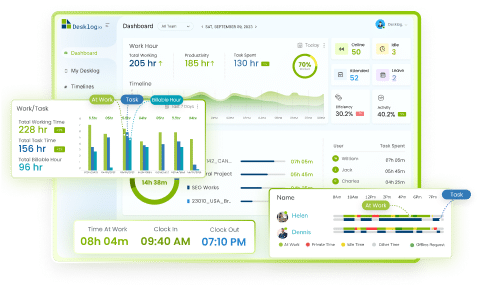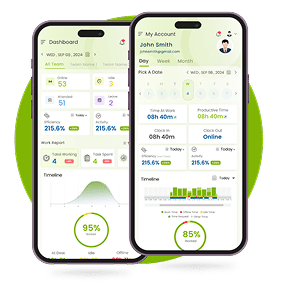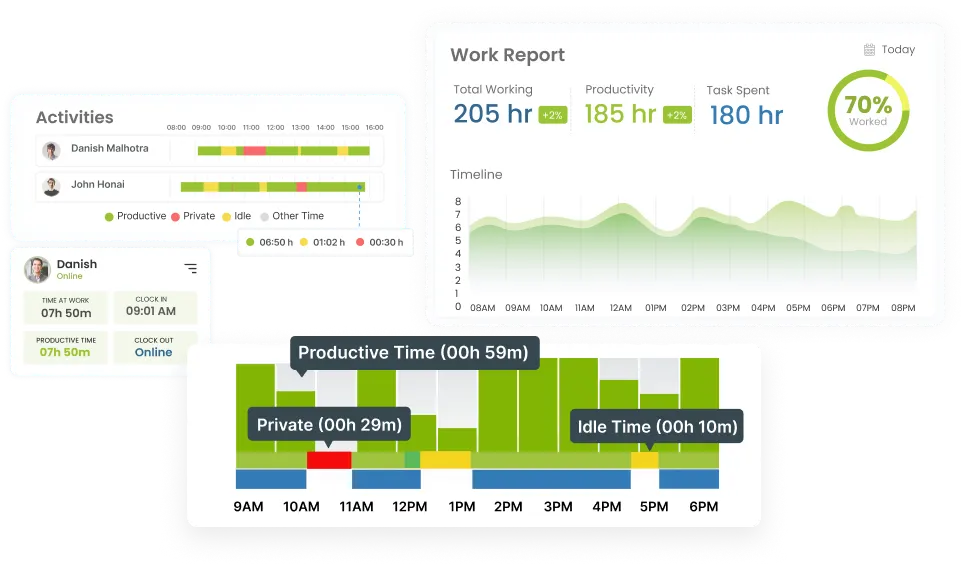According to the World Health Organization, burnout is now recognized as an occupational phenomenon, resulting from chronic workplace stress that hasn’t been successfully managed. Its impact? Reduced productivity, higher absenteeism and rising attrition.
On the flip side, organizations that actively manage workloads see better outcomes: improved morale, lower turnover and stronger performance. According to Gallup, employees who feel their workload is manageable are 70% less likely to experience burnout and 50% more likely to stay with their company long-term.
Now that we’ve highlighted why effective workload management is important, let’s explore how you can balance team productivity without compromising well-being.This guide covers 10 practical tips supported by Desklog time tracking software for ethical time tracking and smarter productivity insights. Here’s an overview of everything we will cover:
- Why Workload Management Matters
- Common Causes of Employee Burnout
- 10 Proven Tips to Manage Workload Effectively Without Burning Out Your Team
Let’s go!
Why Workload Management Matters
Poor workload balance in remote agencies or fast-paced tech teams can quietly chip away at team performance, employee engagement and retention.
The Cost of Poor Workload Management
When workloads are misaligned or left unchecked, the consequences ripple across the business:
- Burnout increases: Continuous pressure without proper support leads to fatigue, disengagement and reduced performance across teams.
- Turnover rises: According to Forbes, 46% of HR leaders say burnout contributes to 20–50% of annual employee turnover, making it a top driver of attrition.
- Deadlines slip: Overloaded employees struggle to meet deadlines, causing project delays, lost revenue and frustrated clients.
- High performers burn out first: High performers are often over-relied on until they hit a wall, leading to unexpected exits and knowledge loss.
The Benefits of Balanced Workloads
When teams are supported by clear priorities, visibility into their tasks and realistic expectations, the difference is clear:
- Higher productivity: Teams perform at their best when they focus on meaningful work instead of juggling too many competing tasks.
- Improved retention: When workloads are manageable and expectations are clear, employees are more likely to stay and grow with the company.
- Stronger team morale: A fair distribution of work reduces stress, builds trust, and encourages collaboration across departments.
- Better decision-making: With clear visibility into capacity, managers can allocate resources, plan ahead, and scale without guesswork.
- Healthier work-life balance: Balanced workloads reduce after-hours work and mental fatigue, helping employees stay energized, focused, and balanced in work and life.
Common Causes of Employee Burnout
Before looking into solutions, it’s important to understand what causes employee burnout in modern teams. Burnout doesn’t just happen overnight. It builds over time due to mismanaged expectations, unclear priorities and lack of visibility.
1. Overloading High Performers
When leaders don’t have visibility into how work is distributed, top-performing employees often receive more tasks simply because they “always deliver.” Over time, this can lead to chronic stress, resentment and eventual disengagement.
2. Lack of Clarity or Prioritization
If everything is urgent, nothing is. When teams don’t know how to properly prioritize tasks, they spend time putting out fires instead of making strategic progress. This leads to frustration and wasted effort.
3. No Visibility Into Real Workload
Without real-time data on how teams are spending their time, managers often underestimate how overloaded people really are. This leads to unrealistic deadlines and missed opportunities to redistribute tasks before burnout sets in.
4. Poor Communication in Remote or Hybrid Teams
Distributed teams often struggle with siloed communication, misaligned expectations and a lack of face-to-face check-ins. Without the right systems in place, burnout goes unnoticed until it’s too late.
10 Proven Tips to Manage Workload Effectively Without Burning Out Your Team
Here are 10 actionable tips to help you balance workloads without burning out your best people:
Tip 1 – Audit Current Workload with Data
Why it matters:
You can’t fix what you can’t see. Before optimizing workloads, managers need a clear picture of how time is actually spent across tasks, projects, and team members.
How Desklog helps:
Desklog’s automated project time tracking feature gives you real-time visibility into where hours are going without invading privacy.
Tip 2 – Organize Work by Priority, Not Pressure
Why it matters:
Without clear priorities, teams often spend energy on low-value work while critically important tasks suffer. Strategic task sorting reduces stress and increases impact.
How Desklog helps:
Desklog’s task tagging system lets you label tasks by priority- Critical, High, Medium, or Low- making it easier to focus on what matters most.
Tip 3 – Distribute Work Based on Skills
Why it matters:
Even capable teams burn out when work isn’t aligned with strengths. Assigning tasks based on skill ensures higher quality, faster delivery and better morale.
How Desklog helps:
Desklog’s performance analytics let you assess who excels at what, so you can delegate intelligently.
Tip 4 – Utilize Offline Time Tracking
Why it matters:
Remote or on-the-go work shouldn’t fall through the cracks. Without proper time capture, managers lose visibility, and freelancers lose billable hours.
How Desklog helps:
Desklog’s offline mode tracks time accurately even without internet access, syncing automatically when back online.
Tip 5 – Track Progress with Configurable Screenshots
Why it matters:
Progress visibility is key, but constant surveillance erodes trust. Ethical check-ins keep projects on track while preserving employee privacy.
How Desklog helps:
Desklog offers configurable screenshots, giving context at customizable intervals (e.g., every 30 mins), so managers stay informed without micromanaging.
Tip 6 – Set Clear KPIs for Workload Health
Why it matters:
Without the right metrics, it’s hard to tell if workloads are manageable or if they’re leading to burnout. KPIs make workload management measurable.
How Desklog helps:
Desklog’s dashboard helps you define and track workload health using KPIs like: Task Completion Rate, Time Spent per Project / Task, Time Spent per Project / Task, Task Distribution by Status etc.
Tip 7 – Foster Open Team Communication
Why it matters:
Data alone doesn’t solve burnout. Teams need space to share challenges and suggestions. Transparency builds trust and continuous improvement.
How Desklog helps:
Desklog’s reports empower non-judgmental discussions about workloads. Managers and team members can review the same objective data to align and adjust.
Tip 8 – Integrate Tools for Smooth Workflows
Why it matters:
Juggling separate systems for time tracking, project management and invoicing leads to errors and wasted time.
How Desklog helps:
Desklog merges time tracking, task management and integrates with billing systems so you can manage everything in one place.
Tip 9 – Schedule Regular Well-Being Checks
Why it matters:
Burnout is easier to prevent than to fix. Early stress detection can protect your people and your project timelines.
How Desklog helps:
Desklog includes built-in wellness features, encouraging healthy habits and helping employees stay refreshed and focused throughout the day.
Tip 10 – Scale Workloads with Desklog’s Insights
Why it matters:
Growth is exciting, but scaling without visibility leads to bottlenecks, burnout, and attrition. Sustainable growth requires strategic workload planning.
How Desklog helps:
Desklog’s Insights Dashboard gives managers a clear view of key workload metrics and productivity patterns to catch early signs of burnout. Together, these insights empower smarter scaling, timely hiring, and sustainable team performance.
Conclusion
Managing workloads is about protecting your people, optimizing performance and building a resilient team that can grow sustainably.
Desklog helps HR managers, project leads, and operations heads make informed decisions based on real data. From time tracking and task prioritization to well-being checks and burnout prevention, it’s a complete solution for teams that care about both output and employee wellness.
By applying these 10 strategies, you can create a culture of productivity, fairness, and transparency where workloads are balanced, goals are met and your best people stay longer.
FAQs
1 What are the signs that a team is overloaded?
Teams that are overloaded often show consistent signs like missed deadlines, declining work quality, increased overtime, employee complaints about workload, and noticeable drops in morale or engagement. If left unaddressed, this can quickly lead to burnout and attrition.
2 How often should workload reviews or audits occur?
Ideally, workload reviews should happen on a monthly or biweekly basis. This frequency allows managers to identify and correct imbalances early, without making the process feel burdensome or overly administrative.
3 What tools help with workload management in remote teams?
All-in-one platforms like Desklog are especially effective for remote teams. They combine automated time tracking, task management, productivity analytics etc. offering the visibility needed to manage distributed workloads efficiently without micromanagement.
4 How can managers prevent burnout among high-performing employees?
To avoid over-reliance on top performers, managers should rotate critical assignments, ensure proper rest periods, track workloads with tools like Desklog, and avoid consistently assigning them the most demanding tasks. Recognition and support also play key roles in long-term engagement.
5 How do you distribute workload fairly across a team?
Fair workload distribution starts with visibility into each team member’s current capacity and strengths. Managers should match tasks based on skills, ensure a balance between complex and routine work, and make adjustments in real time based on ongoing data.
6 Can workload management reduce employee turnover?
Absolutely. When employees feel that work is distributed fairly and expectations are realistic, they’re more likely to stay engaged and loyal. Effective workload management directly impacts job satisfaction and reduces burnout-driven exits.
7 How do managers detect early signs of burnout?
Managers can detect early signs of burnout by paying close attention to behavioral and performance-related changes. Common red flags include a sudden spike in work hours, noticeable drops in focus or output, repeated mistakes or missed deadlines, reduced participation in team communication, and rising absenteeism.
8 Should teams have regular well‑being or stress assessments?
Yes, regular well-being checks are essential for healthy team dynamics. These can include short pulse surveys, quarterly stress assessments, or casual check-ins. When combined with productivity insights, these conversations allow managers to take a proactive approach to employee wellness.

















